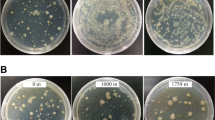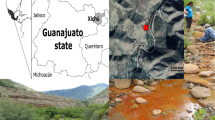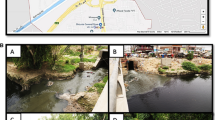Abstract
The Sambhar Salt Lake is a halite rich athalassohaline basin, provides a unique opportunity for microbial ecologists to study halophiles. The lake has a high proportion of Na+ and Cl− ions making it a hypersaline ecosystem. In the current study, archaea and bacteria from Sambhar Lake were isolated using two cultivation approaches. A total of 449 isolates were obtained, out of which 13 represent archaeal while 12 represent bacterial genera. Natronococcus and Alkalibacillus were found predominant groups among archaea and bacteria, respectively. Apart from the common genera in both the approaches Alteribacillus, Halobacillus, Halorubrum, Lentibacillus, Natronorubrum, Piscibacillus and Thalassobacillus were found only in the samples processed onsite however only three genera Aliidiomarina, Natrinema and Natronolimnobius were isolated when samples were processed in the laboratory after transportation using the same growth conditions. Other than the isolation of diverse group of organisms 13 putative novel taxa with similarity less than 98% were identified using 16S rRNA gene sequencing.


Similar content being viewed by others
References
Amoozegar MA, Siroosi M, Atashgahi S, Smidt H, Ventosa A (2017) Systematics of haloarchaea and biotechnological potential of their hydrolytic enzymes. Microbiology 163:623–645
Amoozegar MA, Safarpour A, Noghabi KA, Bakhtiary T, Ventosa A (2019) Halophiles and their vast potential in biofuel production. Front Microbiol 10:1895
Antony CP, Kumaresan D, Hunger S, Drake HL, Murrell JC, Shouche YS (2013) Microbiology of Lonar Lake and other soda lakes. ISME J 7(3):468–476
APHA (1998) Standard methods for the examination of water and wastewater, 20th edn. WEF, Washington, DC
Baricz A, Cristea A, Muntean V, Teodosiu G, Andrei AS, Molnar I (2015) Culturable diversity of aerobic Halophilic archaea (Fam. Halobacteriaceae) from hypersaline, meromictic Transylvanian lakes. Extremophiles 19(2):525–537
Bilen M, Dufour JC, Lagier JC, Cadoret F, Daoud Z, Dubourg G, Raoult D (2018) The contribution of culturomics to the repertoire of isolated human bacterial and archaeal species. Microbiome 6(1):94
DeMarco AL, Rabe LK, Austin MN, Stoner KA, Avolia HA, Meyn LA (2017) Survival of vaginal microorganisms in three commercially available transport systems. Anaerobe 45:44–49
Deocampo DM, Jones BF (2013) Geochemistry of saline lakes. In: Drever J (ed) Treaties on geochemistry, 2nd edn. Elsevier, San Diego, pp 437–469
Elvi R, Assa P, Birbir M, Ogan A, Oren A (2004) Characterization of extremely halophilic archaea isolated from Ayvalik salterns, Turkey. World J Microbiol Biotechnol 20:563–566
Esteves AI, Amer N, Nguyen M, Thomas T (2016) Sample processing impacts the viability and cultivability of the sponge microbiome. Front Microbiol 7:499
Gunde-Cimerman N, Plemenitas A, Oren A (2018) Strategies of adaptation of microorganisms of the three domains of life to high salt concentrations. FEMS Microbiol Rev 42(3):353–375
Kumbhare SV, Dhotre DP, Dhar SK, Jani K, Apte DA, Shouche YS, Sharma A (2015) Insights into diversity and imputed metabolic potential of bacterial communities in the continental shelf of Agatti Island. PLoS ONE 10(6):e0129864
Lane DJ (1991) 16S/23S rRNA sequencing. In: Stackebrandt E, Goodfellow M (eds) Nucleic acids techniques in bacterial systematics. Wiley, Chichester, pp 115–147
Ling LL, Schneider T, Peoples AJ, Spoering AL, Engels I et al (2015) A new antibiotic kills pathogens without detectable resistance. Nature 517:455–459
Reuter JA, Spacek DV, Snyder MP (2015) High-throughput sequencing technologies. Mol Cell 58(4):586–597
Reysenbach AL, Longnecker K, Kirshtein L (2000) Novel bacterial and archaeal lineages from an in situ growth chamber deployed at a Mid-Atlantic Ridge hydrothermal vent. Environ Microbiol 66:3798–3806
Rodriguez-Valera F, Ruiz-Berraquero F, Ramos-Cormenzana A (1980) Isolation of extremely halophilic bacteria able to grow in defined inorganic media with single carbon sources. J Gen Microbiol 119:535–538
Singh BP, Singh N, Singh SP (2013) Modern salt (halite) deposits of the Sambhar Lake, Rajasthan and their formative conditions. Curr Sci 104(11):1482–1484
Sharma A, Shouche Y (2014) Microbial Culture Collection (MCC) and International Depositary Authority (IDA) at National Centre for Cell Science, Pune. Indian J Microbiol 54(2):129–133
Sharma A, Jani K, Shouche YS, Pandey A (2015) Microbial diversity of the Soldhar Hot Spring, India, assessed by analyzing 16S rRNA and protein-coding genes. Ann Microbiol 65:1323
Sharma A, Paul D, Dhotre D, Jani K, Pandey A, Shouche YS (2017) Deep sequencing analysis of bacterial community structure of Soldhar Hot Spring, India. Microbiology 86:136
Sharma A, Jani K, Feng GD, Karodi P, Vemuluri VR et al (2018) Subsaxibacter sediminis sp. nov., isolated from Arctic glacial sediment and emended description of the genus Subsaxibacter. Int J Syst Evol Microbiol 68(5):1678–1682
Sharma A, Jani K, Thite V, Dhar S, Shouche YS (2018) Geochemistry shapes bacterial communities and their metabolic potentials in tertiary coalbed. Geomicrobiol J 36(2):179–187
Acknowledgements
We are grateful to Mr. Kunal Jani for helping us during sampling.
Funding
This work was supported by the Department of Biotechnology (DBT), Government of India (Grant No. BT/Coord.II/01/03/2016) under the Project ‘Establishment of National Centre for Microbial Resource’.
Author information
Authors and Affiliations
Corresponding author
Ethics declarations
Conflicts of interest
The authors declare that there are no conflicts of interest.
Additional information
Publisher's Note
Springer Nature remains neutral with regard to jurisdictional claims in published maps and institutional affiliations.
The GenBank accession number for the 16S rRNA gene sequences of representative strains are MK862575–MK862680.
Electronic supplementary material
Below is the link to the electronic supplementary material.
Rights and permissions
About this article
Cite this article
Kajale, S., Deshpande, N., Shouche, Y. et al. Cultivation of Diverse Microorganisms from Hypersaline Lake and Impact of Delay in Sample Processing on Cell Viability. Curr Microbiol 77, 716–721 (2020). https://doi.org/10.1007/s00284-019-01857-8
Received:
Accepted:
Published:
Issue Date:
DOI: https://doi.org/10.1007/s00284-019-01857-8




